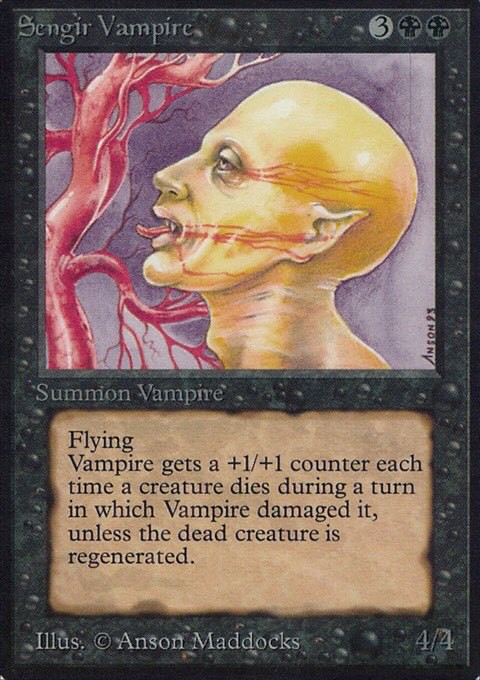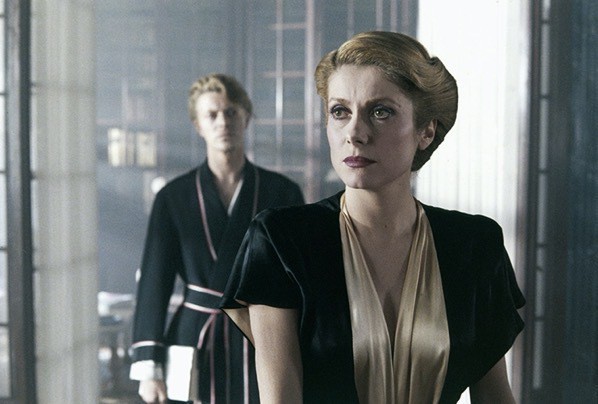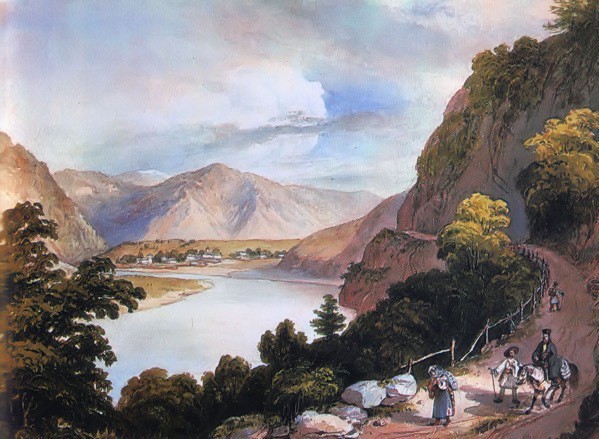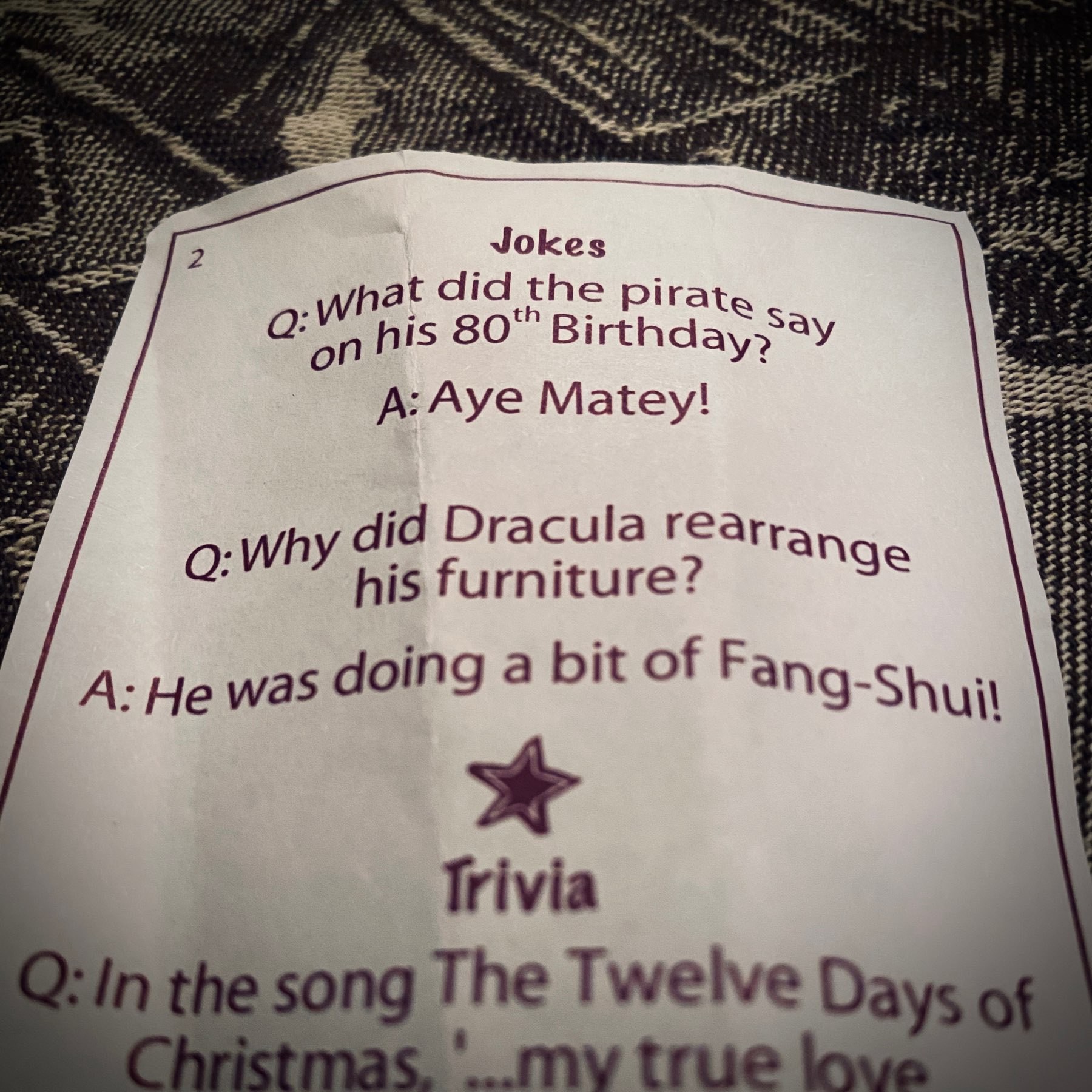Sengir Vampire. Art by Anson Maddocks.

I was very excited about this week’s Doctor Who. Shelley, Byron, and Polidori really did spend time together in summer, 1816. Out of that holiday came Frankenstein and The Vampyre, and it’s the reason I set Wallachia then.

David Bowie and Catherine Deneuve in 1983’s The Hunger. [I initially mis-typed this as “1893” which is, of course, the year Dracula is set.]
7. Wallachia Chapter 1: Welcome to Wallachia
Chapter 1 of Wallachia: A Penny Dreadful by David Ely. The previous six episodes have comprised the prelude, Flowers of Transylvania. Now we jump forward to 1816 and move south to Wallachia.
Marley returns home after several years away and attends her sister’s first Communion. Afterwards, they eat, dance, take in a puppet show, and a strange visitor arrives.
I don’t know how well it works digitally, but The Terrifics 25 is a very fun issue. It lets you make decisions that are legally distinct from a Choose Your Own Adventure book by turning to different pages based on decisions you think the characters should make.
Batman & Dracula: Red Rain is a fun “Elseworlds” Story by Doug Moench. Here’s a collection that includes its that includes its follow-ups Bloodstorm & Crimson Mist.

Turnu Roșu Pass along the Olt River near the southern Transylvania-northern Wallachia border. 1831 watercolor by Miklós Barabás.
6. Flowers of Transylvania Chapter 6: Home At Last
Corina and Dominic arrive at her village.
This marks the end of the Flowers of Transylvania novella. Next time we’ll jump forward 75 years and start Wallachia. We’ll meet a whole new cast of characters, but there will be some famliar faces, settings, and themes that carry over from the prelude.
As always, you can follow Wallachia on Twitter @wallachiaNet. Word of mouth is incredibly helpful, so if you’ve been enjoying the story, please tell your friends.
My brain woke me up at 4:00 or so this morning because it had finally figured out the line of dialogue chapter 10 has been missing. It’s not even something particularly great, just that little bit that let the words start flowing. 😌
John Williams wrote the score for 1979’s Dracula starring Frank Langella.
A Bit More on Count Von Count
Inspired by this letter Children’s Workshop got about Count von Count, here are a few more tidbits about the maladjusted muppet.
One: A YouTube playlist of his early appearances, starting with his first.
Two: physically he resembles Bela Lugosi’s Dracula, adding in a beard and a monocle, a symbol of bygone mainland Europe aristocracy.
Three: Why does he count? We obviously have the pun on his title of nobility. More importantly, as his song goes, he’s called the count because he really likes to count, and there’s some obscure folkloric history there. (Also note that his song is rooted in the style of Eastern European folk music.)
Paul Barber’s Vampires, Burial, and Death: Folklore and Reality notes that in some areas vampires were believed to be arithmomaniacs. He says:
There is also a report of a tribe of Gypsies who believed that vampires could be kept out of the home by casting fishing nets over the doors: “Before the vampire can enter the house, he must count all the knots.”
Barber also mentions a compulsion to count poppy seeds, and that sometimes a person’s coffin would be filled with them to prevent the dead from rising. George Frederick Abbott’s Macedonian Folklore notes:
The visits of a vampire are further guarded against by scattering mustard seed over the tiles of the roof, or by barricading the door with brambles and thorn-bushes. […] The mustard […] is intended to make the Vrykolakas waste his time in counting. The same fatal weakness for arithmetic seems to best the Kalikantzari of Soutern Greece. If a sieve is handed to one, he will set to work to count the holes, as though his life depended on it. […] The Italians use a similar antidote on the Eve of St. John’s Day, when they carry about an onion-flower or a red carnation. This flower is meant for the witches, who are believed to be abroad on that evening. When it is given to them, they begin to count the petals, and long before they have accomplished this feat you are out of their reach.
Naturally, Count von Count has a Twitter account: @CountVonCount. It’s frightfully, delightfully, committed to its bit.
In 1989 Children’s Television Workshop received a letter expressing concern that Sesame Street’s Count von Count might teach children not to be afraid of Dracula.
Ruins of Ravencroft: Dracula №1:
Ravencroft Institute for the Criminally Insane appeared to be a hospital devoted to the rehabilitation of society’s most violent offenders. But appearances can be deceptive, and—as Captain America learned the hard way—some secrets have teeth.
5. Flowers of Transylvania Chapter 5: As the World Falls Down
The morning after finding something terrible beneath the chapel in the village, Corina despairs.
Chapter 9, “Rides in the Rain” is out now. Father Abraham takes a ride in the rain to visit a sick man.
The bit about burning down forests to make quick grazing land comes from Andrew F. Crosse’s Round About the Carpathians:
[The Wallack] hates forests, and will ruthlessly burn down the finest trees to make a clearing for sheep-pastures. It is impossible to travel twenty miles in the Southern Carpathians without encountering the terrible ravages committed by these people in the beautiful woods that adorn the sides of the mountains.
The Wallacks find it too much trouble to fell the trees. […] At present there is wood and enough, but the time will come when the country at large must suffer from this reckless waste.
This sort of sentiment is common in most of the travelogues you read from Western Europeans about the region. They don’t care for the people they perceive to be dirty and less civilized and don’t make any effort to hide it. Were Romanians really burning down their forests out of short-sighted expediency? Maybe. It’s possible the law really should have put a stop to it. I’m sure I could do a bit more research to learn more, but for my purposes what I find so clear is the judgement these authors put upon the people living there. They see a beautiful land and just assume the inhabitants are too stupid to know how to take care of it. So, in my story they’re at least going to debate it first.
For this week’s poll, I’m asking readers to decide whether Radu is going to accept a tip he receives about Cornel’s murderer.
Recording the phrase “soft sheep’s cheese” for the audiobook nearly killed me. I think I had to do six takes and almost just rewrote it. Among the foods Daniella Carmen serves Abraham is mamaliga, a cornmeal dish that Jonathan Harker also mentions eating in the first chapter of Dracula.
The next chapter might be a long one. We’ll follow Margareta and Marley into the forest. I had initially thought it would be two chapters but I think I want to tell the whole story at once.
I’m hoping to have chapter 9 out tomorrow or Thursday. If tomorrow’s a snow day it might slow me down.
I started the chapter off by giving Abraham a bad headache. Coincidentally I got one today that prevented me from doing my last edits.
BBC One has posted a few short documentaries about its new Dracula series (on Netflix in the US):
The count’s ring in the Dracula series is the symbol of the Order of the Dragon. Here’s a shot of it. Wikipedia has more on the Order, which are naturally key characters in Wallachia.
In the BBC/Netflix show, Count Dracula has a new trick: learning languages by drinking blood. Here are the vampiric abilities and traits Bram Stoker gives to Count Dracula in the novel. These are from notes I took when rereading it a few years ago. The most succinct summary comes in chapter 18 when Van Helsing runs through a number of them, but he exhibits other powers throughout the story.
Physical characteristics:
- Hair on the palms of his hands (in Dracula’s case only; the four female vampires we see aren’t described this way)
- Sharp fingernails
- Sharp teeth
- Red eyes
- Complexion of “exceptional pallor”
Abilities:
- “Can command all the meaner things: the rat, and the owl, and the bat – the moth, and the fox, and the wolf”
- Strength of twenty men
- “Of cunning more than mortal, for his cunning be the growth of ages”
- No reflection in mirrors
- Can scale walls vertically like a lizard
- Turns into mist, a dog, a bat, and “moonlight rays as elemental dust”
- Create a storm and fog around himself
- Can incite the insane to his aid from long distances (Transylvania to London)
- Can secure girls from a long distance, causing them to sleepwalk and lose pallor
- Victims do not decay in death before their undeath begins
- Strength of twenty men
- More cunning than mortal man, “for his cunning be the growth of ages”
- Has the aids of necromancy
- Can grow and become small to slip through a “hairbreadth space”
- “Throws no shadow”
- Cannot die by mere passing of the time
- Can grow younger by drinking the blood of the living
- Can see in the dark
- His victims can be made to forgot his attacks, and he has mental control over them, so he can command them to come at will, for example.
Limitations:
- Afraid of the Crucifix
- Repulsed by the Sacred Wafer; unable to pass by it if it’s crumbled up and placed in a doorway or made into a circle
- Physical contact with a consecrated Host will burn a vampire’s skin, leaving a mark
- Must travel in a coffin (meaning large box, not necessarily a burial coffin) filled with soil
- Cannot stand the smell of garlic
- When asleep, face is like the dead (unable to move or react)
- To kill: cut off head, fill mouth with garlic, drive stake through body (though a Bowie knife will also do)
- “A sacred bullet fired into the coffin kill him so that he be true dead”
- The branch of the wild rose placed over coffin will prevent the ability to exit
- “Cannot flourish” without drinking blood
- “He may not enter anywhere at the first, unless there be some one of the household who bid him to come; though afterwards he can come as he please”
- Power ceases at the coming of the day (sunrise)
- “Only at certain times can he have limited freedom. If he be not at the place whither he is bound, he can only change himself at noon or at exact sunrise or sunset.”
- “Can only pass running water at the slack or the flood of the tide”
- Harker strikes him while he’s asleep in his coffin and this scar persists throughout the novel.
Sunlight has no particular effect on the count, aside from that his powers cease during the daytime. He’s seen out during the day in the novel.
I quite liked the first episode of BBC One/Netflix’s Dracula. It plays with the source well and brings a good creepy, campy horror. I’m looking forward to the next two. 🧛🏻♂️📺
4. Flowers of Transylvania Chapter 4: Into the Labyrinth
Corina and the girls visit the village, and she makes a startling discovery.
This was in my Christmas cracker tonight.

Chapter 8 of Wallachia, “Goings and Comings,” is out now.
- The Order gets some orders
- The trouble with tributes
You can download and read it for free.
3. Flowers of Transylvania Chapter 3: Day and Night in Castle Dracula
Corina and Dominic connect; she starts having bad dreams.